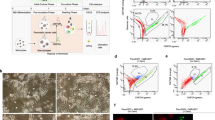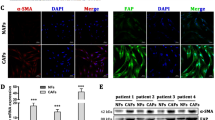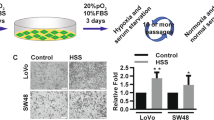Abstract
The tumor microenvironment (TME) consists of various cell types, including fibroblasts. The TME plays a central role in the promotion of tumor progression. In the present study, we investigated whether lysophosphatidic acid (LPA) receptor-mediated signaling regulates cellular functions by the TME of pancreatic cancer PANC-1 cells. To obtain fibroblast 3T3 cell supernatants, 3T3 cells were cultured in 5% charcoal stripped FCS-DMEM for 48 h. LPAR2 and LPAR3 expression levels were elevated in PANC-1 cells cultured in 3T3 cell supernatants. While PANC-1 cell motility was decreased by 3T3 cell supernatants, the cell survival to cisplatin (CDDP) of PANC-1 cells was markedly enhanced. Moreover, the cell survival to CDDP of PANC-1 cells cultured in 3T3 cell supernatants was increased by GRI-977,143 (LPA2 agonist) and (2 S)-OMPT (LPA3 agonist). Since hypoxia is caused by the restriction of adequate vascular networks to deliver oxygen into solid tumors, PANC-1 cells were cultured in 3T3 cell supernatants at 1% O2 conditions. The cell survival to CDDP of PANC-1 cells cultured in 3T3 cell supernatants at 1% O2 was significantly elevated, correlating with LPAR2 and LPAR3 expressions. These results suggest that LPA signaling via LPA2 and LPA3 is involved in the promotion of malignant properties by the TME in PANC-1 cells.





Similar content being viewed by others
Data Availability
All data generated or analyzed during this study are included in this published article.
References
Aikawa S, Hashimoto T, Kano K, Aoki J (2015) Lysophosphatidic acid as a lipid mediator with multiple biological actions. J Biochem 157:81–89
Alkasalias T, Moyano-Galceran L, Arsenian-Henriksson M, Lehti K (2018) Fibroblast in the tumor microenvironment: shield or spear? Int J Mol Sci 19:1532
Aoki J, Inoue A, Okudaira S (2008) Two pathway for lysophosphatidic acid production. Biochim Biophys Acta 1781:513–518
Auciello A, Bulusu V, Oon C, Tait-Mulder J, Berry M, Bhattacharyya S, Tumanov S, Allen-Petersen BL, Link J, Kendsersky ND, Vringer E, Schung M, Novo D, Hwang RF, Evans RM, Nixon C, Dorrell C, Morton JP, Norman JC, Sears RC, Kamphorst JJ, Sherman MH (2019) A stroma lysolipid-autotaxin signaling axis promotes pancreatic tumor progression. Cancer Discov 9:617–627
Bissell MJ, Radisky D (2001) Putting tumours in context. Nat Rev Cancer 1:46–54
Brown JM, Wilson WR (2004) Exploiting tumour hypoxia in cancer treatment. Nat Rev Cancer 4:437–447
Feig C, Gopinathan A, Neesse A, Chan DS, Cook N, Tuveson DA (2012) The pancreas cancer microenvironment. Clin Cancer Res 1:4266–4276
Fukushima K, Takahashi K, Yamasaki E, Onishi Y, Fukushima N, Honoki K, Tsujiuchi T (2017) Lysophosphatidic acid signaling via LPA1 and LPA3 regulates cellular functions during tumor progression in pancreatic cancer cells. Exp Cell Res 352:139–145
Geraldo LHM, Spohr TCLS, Amaral RFD, Fonseca ACCD, Garcia C, Mendes FA, Freitas C, dosSantos MH, Lima FRS (2021) Role of lysophosphatidic acid and its receptors in health and disease: novel therapeutic strategies. Signal Trandsuct Target Ther 6:45
Hamilton G, Rath BA (2014) A short update on cancer chemoresistance. Wine Med Wochenschr 164:456–460
Hasegawa Y, Erickson JR, Goddard GJ, Yu S, Liu S, Cheng KW, Eder A, Bandoh K, Aoki J, Jarosz R, Schrier AD, Lynch KR, Mills GB, Fang X (2003) Identification of a phsphothionate analogue of lysophosphatidic acid (LPA) as a selective agonist of the LPA3 receptor. J Biol Chem 278:11962–11969
Ishii S, Hirane M, Fukushima K, Tomimatsu A, Fukushima N, Tsujiuchi T (2015) Diverse effects of LPA4, LPA5 and LPA6 on the activation of tumor progression in pancreatic cancer cells. Biochem Biophys Res Commun 461:59–64
Itoi F, Tokoro M, Terashita Y, Yamagata K, Fukunaga N, Asada Y, Wakayama T (2012) Offspring from mouse embryos developed using a simple incubator-free culture system with a deoxidizing agent. PLoS ONE 7:e47512
Jinno N, Yoshida M, Hayshi K, Naitho I, Hori Y, Natsume M, Kato A, Kachi K, Asano G, Atsuta N, Sahashi H, ataoka H (2021) Autotaxin in ascites projotes peritoneal dissemination in pancreatic cancer. Cancer Sci 112:668–678
Kalluri R, Zeisberg M (2006) Fibroblasts in cancer. Nat Rev Cancer 6:392–401
Kim I, Choi S, Yoo S, Lee M, Kim IS (2022) Cancer-associated fibroblasts in the hypoxic tumor microenvironment. Cancers 14:3321
Kiss GN, Fells JI, Gupte R, Lee SC, Liu J, Nusser N, Lim KG, Ray RM, Lin FT, Parrill AL, Sümegi B, Miller DD, Tigyi G (2012) Virtual screening for LPA2-specific agonist identifies a nonlipid compound with antiapoptotic actions. Mol Pharmacol 82:1162–1173
Komachi M, Tomura H, Malchinkhuu E, Tobo M, Mogi C, Yamada T, Kimura T, Kuwabara A, Ohta H, Im D-S, Kurose H, Takeyoshi I, Sato K, Okajima F (2009) LPA1 receptors mediate stimulation, whereas LPA2 receptors mediate inhibition, of migration of pancreatic cancer cells in response to lysophosphatidic acid and malignant ascites. Carcinogenesis 30:457–465
Kumari S, Advani D, Sharma S, Ambasta RK, Kumar P (2021) Combinatorial therapy in tumor microenvironment: where do we stand? Biochim Biophys Acta Rev Cancer 1876:188585
Mahadevan D, Von Hoff DD (2007) Tumor-stroma interactions in pancreatic ductal adenocarcinoma. Mol Cancer Ther 6:1186–1197
Matsumura Y (2012) Cancer stromal targeting (CAST) therapy. Adv Drug Deliv Rev 64:710–719
Minami K, Ueda N, Maeda H, Ishimoto K, Otagaki S, Tsujiuchi T (2019) Modulation of chemoresistance by lysophosphatidic acid (LPA) signaling through LPA5 in melanoma cells treated with anticancer drugs. Biochem Biophys Res Commun 517:359–363
Muz B, de la Puente P, Azab F, Azab AK (2015) The role of hypoxia in cancer progression, angiogenesis, metastasis, and resistance to therapy. Hypoxia 3:83
Pennacchietti S, Michieli P, Galluzzo M, Mazzone M, Giordano S, Comoglio PM (2003) Hypoxia promotes invasive growth by transcriptional activation of the met protooncogene. Cancer Cell 3:347–361
Petrova V, Annicchiarico M, Melino G, Amelio I (2018) The hypoxic tumour microenvironment. Oncogenesis 7:10
Radhakrishnan R, Ha JH, Jayaraman M, Liu J, Moxley KM, Isidoro C, Sood AK, Song YS, Dhanasekaran DN (2019) Ovarian cancer cell-derived lysophosphatidic acid induces glycolytic shift and cancer-associated fibroblast-phenotype in normal and peritumoral fibroblasts. Cancer Lett 442:464–474
Stoddard NC, Chun J (2015) Promising pharmacological directions in the world of lysophosphatidic acid signaling. Biomol Ther 23:1–11
Stromnes IM, DelGiorno KE, Greenberg PD, Hingorani SR (2014) Stromal reengineering to treat pancreas cancer. Carcinogenesis 35:1451–1460
Tsujiuchi T, Araki M, Hirane M, Dong Y, Fukushima N (2014) Lysophosphatidic acid receptors in cancer pathobiology. Histol Histopathol 29:313–321
Ueda N, Minami K, Ishimoto K, Tsujiuchi T (2020) Effects of lysophosphatidic acid (LPA) receptor-2 (LPA2) and LPA3 on the regulation of chemoresistance to anticancer drug in lung cancer cells. Cell Signal 69:109551
Yamamoto K, Iwadate D, Kato H, Nakai Y, Tateishi K, Fujishiro M (2022) Targeting the metabolic rewiring in pancreatic cancer and its tumor microenvironment. Cancers 14:4351
Acknowledgements
This research was supported by JSPS KAKENHI Grant Numbers JP18K07249, 21K07109.
Author information
Authors and Affiliations
Contributions
M.T. carried out all experiments and analyzed the results. A.O., Y.A., N.Y., K.H. and M.Y. supported the cell culture studies. T.T. designed this study and wrote the manuscript. All authors have read and approved the final version of the manuscript.
Corresponding author
Ethics declarations
Conflict of interest
The authors declare that they have no conflict of interest.
Ethics declarations
Not applicable.
Additional information
Publisher’s Note
Springer Nature remains neutral with regard to jurisdictional claims in published maps and institutional affiliations.
Electronic supplementary material
Below is the link to the electronic supplementary material.
Rights and permissions
Springer Nature or its licensor (e.g. a society or other partner) holds exclusive rights to this article under a publishing agreement with the author(s) or other rightsholder(s); author self-archiving of the accepted manuscript version of this article is solely governed by the terms of such publishing agreement and applicable law.
About this article
Cite this article
Takai, M., Okuda, A., Amano, Y. et al. Effects of LPA receptor-mediated signaling on the modulation of cellular functions of pancreatic cancer cells cultured in fibroblast supernatants under hypoxic conditions. J Bioenerg Biomembr 55, 169–177 (2023). https://doi.org/10.1007/s10863-023-09969-4
Received:
Accepted:
Published:
Issue Date:
DOI: https://doi.org/10.1007/s10863-023-09969-4




